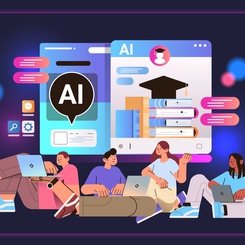Data are central to digital transformation and are a key ingredient to the operational excellence and competitiveness of all organizations. Managers need to harness the value of data to make evidence-based decisions at speed and scale. To this end, they rely on Business Intelligence (BI), defined as the technologies and processes for collecting, blending, modeling, analyzing and visualizing data to gain insights and make better decisions.
Professor Nicolas Prat is specialized in business intelligence and has observed the evolution of the field as it progressed from the early years of data warehouses to augmented (a.k.a. AI-powered) analytics (1). In his latest research on the topic, an early version of which was presented at the International Conference on Information Systems (ICIS), he uses a process view to investigate the possible applications of generative AI to BI, as well as the risks and limitations of these applications (2). Generative AI and large language models (LLMs) emerged as a major topic when OpenAI released ChatGPT to the public in November 2022. Generative AI uses data to create new content. With applications throughout the BI process, generative AI brings about a new revolution in this domain, as epitomized by the term “generative BI.”
Generative AI throughout the business intelligence process
Drawing on the data analytics cycle (1), the BI process comprises four activities, decomposed into tasks:
-
Business problem and opportunity identification: problem formulation, opportunity identification
-
Data sourcing and preparation: data sourcing (getting the data), data modeling (e.g., relational modeling), data profiling (getting a sense of the quality of data), and data transformation (e.g., data cleaning to improve quality)
-
Data discovery and visualization: visualization creation (e.g., reports or dashboards), visualization interpretation, machine learning (e.g., text mining or advanced analytics), and, finally, data storytelling to share insights from data, focusing on the “so what” for managers
-
Decision and action based on the insights.
Typically, the BI process is not purely sequential, involving multiple iterations between activities or between tasks within an activity. For example, data profiling may reveal the need to get complementary data. Generative AI may apply throughout this process, from business problem and opportunity identification to decision and action. The examples below are just a sample of applications of generative AI to BI.
In business problem and opportunity identification, generative AI may be used to evaluate the strengths and weaknesses of the organization in problem formulation, and to analyze the competitive environment in opportunity identification.
In data sourcing and preparation, generative AI may suggest external datasets in data sourcing. It may generate SQL code (relational modeling). The ability of generative AI to generate code from text can also improve the productivity of data transformation.
The activity of data discovery and visualization is central to BI. Generative AI enables interacting with BI tools in natural language. This includes using natural language to create visualizations (e.g., “Show the monthly evolution of sales in Northern Europe over the last two years”), modify visualizations, and interpret data or visualizations to generate insights in natural language. Predictive analytics may also suggest relevant visualizations based on the context. Machine learning enables analyzing unstructured data (e.g., customer sentiment analysis from text) or performing advanced analytics (e.g., identifying patterns to predict customer attrition). Generative AI stands out for its ability to create stories, which is applicable to data storytelling.
Finally, in decision and action, generative AI may make recommendations (for example, suggest investment strategies) based on the insights from data.
The promises of generative BI
The applications of generative AI mentioned above differ in their maturity level. Some are not yet implemented or only partly implemented in mainstream BI tools like Power BI or Tableau. Other applications (such as the ability to suggest potentially relevant visualizations based on context) were already there before the advent of generative AI. Two characteristics that contribute to making generative BI a revolution are (1) the ability to create new content (e.g., in data storytelling) and (2) the ability to create and consume insights from data through dialogue in natural language (similarly to ChatGPT). The personalization capabilities of generative AI contribute to tailoring BI to specific users and contexts (e.g., personalized visualizations or recommendations). Even if this objective seems fairly out of reach today, generative BI also promises to remove the silos often observed in BI, both between data and decision makers. Ideally, decision makers should be able to generate, consume, and share insights from data as part of their everyday work.
Both data professionals (e.g., data scientists, business or data analysts, and data engineers) and business users may benefit from the advent of generative BI. Thanks to productivity gains, data professionals can concentrate on the tasks where they have the most added value (e.g., liaising with business stakeholders). For their part, business users are further empowered to generate and consume insights from data, without necessarily needing help from data professionals or the IT department: the dream of self-service BI is becoming increasingly reality, with generative BI facilitating evidence-based decisions at speed and scale.
The limits and perils of generative BI
BI is fueled by data. However powerful the BI tools and underlying models may be, bad data result in flawed insights, undermining the whole decision process. Even though generative BI may facilitate data cleaning, it is not a miracle remedy for data quality problems, and data cleaning cannot address all quality issues. Therefore, generative BI should have quality data to start with.
The common risks associated with generative AI are found in generative BI. Biases in data used to train LLMs may be reflected in the recommendations that they make. Data privacy and security are also major concerns: companies should ensure that personal and confidential data remain under their control. Hallucinations are also a risk, e.g., when generative BI makes recommendations based on insights.
Data and AI governance can help manage the risks associated with generative BI, against a backdrop of increased regulation, such as the General Data Protection Regulation (GDPR) and the recent AI Act in the European Union.
Conclusion
Even though the integration of generative AI in mainstream BI tools is still at an early stage (e.g., Copilot for Power BI), this technology has profound implications for all activities of the BI process. After augmented analytics, generative BI is the new revolution of BI, further democratizing generation and consumption of insights, and accelerating the speed and scale of evidence-based decision making. Companies should embrace this opportunity, while keeping control of their data and managing the risks of generative AI through data and AI governance.
References
-
Prat, N. (2019). Augmented analytics. Business & Information Systems Engineering, 61, 375–380.
-
Prat, N. (2023). The impact of generative AI on business intelligence. ICIS 2023 TREOS. 101. https://aisel.aisnet.org/treos_icis2023/101









